Now Reading: Top 10 Best Places to Visit in Nakhon Phanom – Temples, Culture & Nature
-
01
Top 10 Best Places to Visit in Nakhon Phanom – Temples, Culture & Nature

Top 10 Best Places to Visit in Nakhon Phanom – Temples, Culture & Nature
1.Satanakarart The GOD OF Naka

On the edge of the Mekong River at Nakhon Phanom, Thailand, the Phaya Si Sattanakharat monument combines art, spirituality and cultural heritage. The 15 meters tall Naga sculpture, full of great detail, was made from brass and finished in 2016 before becoming a recognized landmark in the area.
- The meaning and spiritual significance of symbols.
- In Thai and Southeast Asian legends, the Naga is considered an important snake god tied to gods of water, reproduction and defense. The seven-headed Naga is especially respected in Buddhist tradition. The legend says that Naga Mucalinda kept the Buddha safe from a storm while he was meditating, showing respect .
- The monument of Phaya Si Sattanakharat due north towards Laos is meant to protect from invasions. Its existence represents the supervision of the city and her river which mirror the traditional convictions of the community .
- Architectural Marvel
- A brass statue of more than 9 tons is supported by an octagonal base that stands 5 meters above ground. The serpent’s many heads and coils are carefully depicted, but each one seems to show majesty and vigilance. Sometimes, water appears to spray from the statue’s mouth which represents wealth and the importance of water .
- There is a small exhibit inside the monument’s base which explains the process behind its creation and the stories of the Naga people.
- Cultural Celebrations
- The Phaya Si Sattanakharat monument draws attention and attracts people because it is both beautiful and special for religious reasons. The province of Nakhon Phanom hosts a yearly festival for the Naga, with traditional shows, processions and offerings by the community. The festival emphasizes what Naga figures mean to local fiction and the way they influence the spiritual lives of people in the community.
- At the end of Buddhist Lent, many people assemble alongside the Mekong River to watch strange orbs of light called Naga fireballs that come from the water. Even though science cannot explain them, these fireballs are believed to be a sign of the Naga’s devotion to the Buddha .
2.Wat Maha That Temple

Sitting by the quiet Mekong River in Nakhon Phanom is Wat Maha That (วัดมหาธาตุ) which reflects the rich Buddhist traditions in Thailand. Built by a general representing the city of Vientiane in 607 CE, the temple has always been important to both the local people and visitors.
Historical Significance
Originally called “Wat Ming Muang,” the temple renamed itself “Wat Maha That” when it received and enshrined some sacred Buddha remains. Between 1920 and 1922, Phraya Maha Ammat, the military leader from Vientiane, organized the building of the temple’s most important stupa, Phra That Nakhon. At the base of this 24-meter-high square building are relics from the Buddha and it is regarded as the birthday stupa for anyone born on Saturdays. It is believed by devotees that praying in this place brings good luck, wealth and well-being .
Architectural Features
What makes Phra That Nakhon famous is its white walls decorated in gold which mix styles from both the Khmer and Lao traditions. Besides the other sculptures, one group also highlights a Naga snaking out of a Makara which means the birth of Buddhism from Hindu legends.
Value due to beliefs and customs
Wat Maha That is one of the nine holiest chedis in Nakhon Phanom and it is important to the local community’s religions practices. Many people, especially Saturdays’ babies, go on temple visits to earn merit because they believe certain temples are linked to each day.
Visitor Information
- The address is Sunthon Wichit Road, Nai Mueang Subdistrict, Mueang Nakhon Phanom District, Nakhon Phanom Province, Thailand
- The staff is here everyday from 08:30 in the morning to 16:30 in the evening.
- You do not have to pay to attend and donations are appreciated.
3.Thai-Vietnamese Friendship Village

The Thai-Vietnamese Friendship Village, in the province of Nakhon Phanom, was built in Ban Na Chok (originally Ban May) and serves as an important reminder of how strong Thai-Vietnamese relations are. President Ho Chi Minh spent a short stint in Thailand during the late 1920s which this site aims to show and share with the Vietnamese community there.
Historical Background
In the year 1928, working as Thau Chin, Ho Chi Minh stayed in Ban Na Chok to orchestrate activities leading to Vietnam’s independence from colonialism. He joined in English training, weddings and special events with the Vietnamese community, hoping to boost unity and encourage their development. His influence on the village was strong and it became a major place for remembering his legacy later.
Importance in Cultures and Diplomacy
The village is both a place with historical value and a busy center for cultural sharing and group activities. The monument demonstrates the close friendship between Thailand and Vietnam, while also appreciating what the Vietnamese community gives in Thailand. Regularly, the village organizes events and ceremonies that help India and Pakistan understand each other better.
Visitor Information
- Ban Na Chok, in the Nong Yat Subdistrict of the Mueang District of Nakhon Phanom, Thailand.
- Tourists can come any day between 8:00 AM and 5:00 PM.
- Entry is free of any charges.
4.Mekong Underwater World

Located close to the Nong Yat Reservoir in the province of Nakhon Phanom, Mekong Underwater World is a freshwater aquarium with interactive displays showing the many types of fish that live in the Mekong River and its streams. The aquarium was set up to spread knowledge and help conserve freshwater creatures, so it displays many species, many of which are rare and in danger, highlighting the diversity in the area.
The significance of Historical and Cultural Background
Adjacent to the aquarium is the Nong Yat Reservoir which is historically important because it was visited by King Bhumibol Adulyadej and Queen Sirikit in 1962. Breeding in the reservoir gives different aquatic species a home and supports the area’s desire to protect its natural resources.
Visitor Information
- Place: Nong Yat Subdistrict, in the Mueang Nakhon Phanom District of Nakhon Phanom with a postcode of 48000.
- Operating Hours:
- Monday through Friday, hours of operation are 9:00 AM to 5:00 PM.
- All weekends, the museum is open from 10:00 AM to 6:00 PM.
- Admission Fees:
- Adults need to pay 30 Baht.
- Admission for Children is 20 Baht
5.Nakhon Phanom Provincial Governor’s Residence Museum

Overlooking the peaceful Mekong River, the Nakhon Phanom Provincial Governor’s Residence Museum displays the treasure trove of history and architecture of this area. The well-preserved colonial-era building allows guests to see the evolution of Nakhon Phanom in both its administration and culture.
Historical Background
In the years 1912-1915, the first Nakhon Phanom governor, Phra Phanom Nakananurak, had the residence built influenced by French-Indochinese design which includes its two-story brick walls, archways and detailed stucco carvings. King Bhumibol Adulyadej and Queen Sirikit arrived in Phichit for a royal visit in 1955, making the mansion receive a major restoration. It was the governor’s home until 1984 and then it went through a number of changes before being refurbished and made into a museum in 2008.
Museum Exhibits
- The first floor displays pictures and life stories of each past governor, letting people see the governing history of the province. Also, exhibits feature the variety of cultures in Nakhon Phanom, pointing out the similar lifestyles and traditions of Thai, Lao and Vietnamese people.
- The 1955 royal visit is the central theme on the Second Floor which includes pictures and details. You can see the bedroom the King and Queen used, keeping its design from the time they came to America.
- Rear Building is also known as Huan Hua Fire or the Steamboat House, where the history and making of Nakhon Phanom’s traditional steamboats can be seen, significant in the province’s cultural events.
Visitor Information
- Adress: 802 Sunthon Wichit Road, Nai Mueang Subdistrict, Mueang Nakhon Phanom District, Nakhon Phanom 48000, Thailand
- Wednesday to Sunday, 10:00 AM to 7:30 PM is the operating period.
- Getting in is free for everyone
6.Ho Chi Minh House

Standing quietly in the peaceful Nakhon Phanom province town of Ban Na Chok, the Ho Chi Minh House holds important place in the history of Southeast Asia. Erected from wood and usually called Uncle Ho’s House, the building allows visitors to see what Ho Chi Minh’s life was like when he was in exile as a revolutionary leader.
Historical Background
In the period between 1928 and 1929, Ho Chi Minh (pseudonym: Thau Chin) lived in Ban Na Chok as he led the struggle to free Vietnam from France. He met with Vietnamese people to spread the value of learning and preserve their culture. He worked with Vietnamese communities by starting schools in their language and also took part in growing coconuts and star fruits, many of which remain alive today.
After the original building was destroyed by time, it was carefully recreated in 2001 following information from people living there with Ho Chi Minh .
Cultural and Diplomatic Importance
Ho Chi Minh House and Friendship Village represent the lasting friendship between Thailand and Vietnam. This place celebrates not only Ho Chi Minh’s work for Vietnam’s independence but also the backing he got from Thai people in a crucial time.
The Vietnamese government gave 45 million baht in 2013 to improve the memorial site which highlighted its importance as a landmark of culture and history .
Visitor Information
- Ban Na Chok, Nong Yat Subdistrict, Mueang District, Nakhon Phanom 48000
- Daily, the museum is open from 8:00 AM until 5:00 PM
- Getting in is free for everyone.
7.Vietnamese Memorial Clock Tower

Located gracefully by the Mekong River in Nakhon Phanom, the Vietnamese Memorial Clock Tower symbolizes the appreciation, strength and lasting friendship between Vietnam and Thailand.
- Historical Significance
- During the Vietnam War, Vietnamese expatriates in Nakhon Phanom raised funds and constructed the clock towers as a thank you to the Thai King and Government. When Vietnam was in turmoil, Thailand gave protection and aid to Vietnamese refugees. On their way home to Vietnam, the Vietnamese community constructed the tower to thank the community for all their generosity.
- The architecture of the tower includes Vietnamese traditions, mixed together with ideas from the region. Four clocks sit on the four sides of the monument and there are remembering inscriptions written in Thai and Vietnamese about the same occasion. A small house nearby keeps reminders and images of the Vietnamese community that once lived in Nakhon Phanom .
The role of culture and diplomacy are very significant here.
As well as being beautiful, the Vietnamese Memorial Clock Tower reflects how the Thai and Vietnamese peoples are united through respect and mutual admiration. It stands for how Vietnamese refugees successfully became part of the community in Nakhon Phanom and contributed to the local culture. It acts as a symbol of the lasting diplomatic and strategic relationship that has been built between these countries .
Visitor Information
- Nai Mueang Subdistrict, Mueang Nakhon Phanom District, Nakhon Phanom 48000
- The store stays open every day from 24 to 24.
- People can explore the gardens free of any charges.
8.Saint Anna Nong Saeng Catholic Church

Saint Anna Nong Saeng Catholic Church in Nakhon Phanom is placed by the Mekong River, shining as a symbol of faith and elegant architecture. Since 1926, the Roman Catholic church here has been a site for worship as well as an important sign of the region’s cultural heritage and history.
Historical Background
The construction of the church took place in 1926 at the time when many Vietnamese immigrants came to Nakhon Phanom. Because of these immigrants, Catholicism was introduced and prospered living in this peaceful riverside area. When the church was built, it greatly helped the Vietnamese community to fit into Thai society.
- Architectural Significance
- Saint Anna Nong Saeng stands out because of its French colonial style. Two tall towers, joined by a high footbridge, recall the appearance of Bangkok’s Assumption Cathedral in the design. The outside of the church is highlighted by a big courtyard and a statue of Saint Anna comforting the young girl which makes the place even more peaceful.
- Inside, the church has wide wooden pews and has windows decorated with colorful stained-glass pictures of events from Jesus’s life. The design indoors makes the room calming and respectful, ideal for prayer and meditation.
- Cultural and Religious Significance
- The church is important for its architecture and for its cultural and religious value. For the Catholic community in the area, Thai, Vietnamese, Laotian and Chinese, the Catholic church is a place of spiritual refuge. That the church exists for so long proves how different religions and cultures live together peacefully in Nakhon Phanom.
- Through the entrance of the church is a building built in the 1950s that is being turned into a museum displaying the church’s history for the area. This plan is meant to save and inform visitors about the spiritual culture of Nakhon Phanom.
Visiting Information
- The address is Sonthornvijit Road, Nai Mueang Subdistrict, Mueang Nakhon Phanom District, Nakhon Phanom 48000, Thailand.
Operating Hours:
- Every weekday: from 06:15
- The festival starts its first day at 06:30.
- Sunday has sessions beginning at 07:00 and ending at 19:00.
- It does not cost anything to get in.
9.Wat Okat Si Bua Ban

Wat Okat Sin Son Ban, though shortened to Wat Okat, sits on the peaceful banks of Mekong River in Nakhon Phanom in Thailand and is famous for its history, legends and its spiritual importance. This temple is dubbed the “Opportunity Temple” as people go there hoping for blessings in business, advancement and new paths.
- Historical Significance
- Thought to go back to 784 CE during the reign of the Si Khotrabun Kingdom, Wat Okat is older than Nakhon Phanom. Local traditions and spiritual goals are woven into the temple’s historic background.
- Purified water and two sacred Buddha statues called Phra Tio and Phra Thiam are at the very core of Wat Okat. A legend says that during the building of a royal barge, a Tio wood log was hard to move which caused people to think the log held a guarding spirit. King Si Khotrabun had the log turned into a Buddha statue which became known as Phra Tio. After the original was lost in a fire, people built a replica temple called Phra Thiam. Amazingly, the true Phra Tio washed up in the Mekong River and was brought back together with its replica, showing how they were both protected and strong .
Famous Art and Great Design
The murals at Wat Okat display the Jataka tales which recount the earlier lives of the Buddha. The ceiling is painted red and dotted with golden stars and the walls are filled with angelic pictures and ornate Thai designs. A special thing to notice is that the wooden shutters in the temple are decorated with carvings of Nareepon, mythical fruit maidens which highlight the temple’s tradition in art.
- Significance to Culture and Beliefs
- Apart from its history and art, Wat Okat provides a peaceful place where people look for help and blessings. A lot of people visit the temple to pray for their careers, earning it the title “Opportunity Temple” .
- Both Phra Tio and Phra Thiam are carried through the town during the 6th lunar month’s full moon by temple attendants and local people join in to offer prayers and participate in the festivities.
Visitor Information
- You can find Dr. Noppharus Amnuay at Sunthon Wichit Road, in Nai Mueang Subdistrict, Mueang Nakhon Phanom District, Nakhon Phanom 48000, Thailand
- Daily, The Administration Area is open from 08:30 AM to 4:30 PM.
- Admission: Free
10.San Lak Mueang Nakorn Phanom

The City Pillar Shrine, known as San Lak Mueang Nakhon Phanom, illustrates the position of Nakhon Phanom in history and spiritual customs. Many Thai cities mark their foundation by establishing a city pillar which gives the city its spiritual strength.
- Historical Significance
- Thailand has a long tradition of setting up Lak Mueang, a type of city pillar which reaches back to ancient history. Usually, the pillars are sacredly created from acacia (chaiyapreuk) and believed to house Chao Pho Lak Mueang, the spirit guarding the city. Bangkok became the new capital in 1782 and King Rama I set up the first city pillar to signify the spiritual heart of the city.
- Although exact historical information about how and why the Nakhon Phanom city pillar was built is scarce, it is clear that, by tradition, it was put up as the central point of the city’s spiritual life. The pillar represents the city’s identity and it’s expected to protect and enrich its residents.
- The role of culture and religion is very important here.
- San Lak Mueang Nakhon Phanom isn’t only an old monument; it downtown area is bustling with religious activities. Visitors as well as locals come here to pray for good luck, good health and protection against misfortune. During such events, important celebrations are held and special events are held to honor the guardian spirit.
- Honoring the city pillar shows the peaceful coexistence of Buddhist and Brahmin traditions in Thailand. Traditionally, items used in worship are incense, candles, flowers and colorful cloths, each one showing a type of devotion and hope.
Visitor Information
- The place: San Lak Mueang Nakhon Phanom is found in the center of Nakhon Phanom city, so visitors can easily reach it.
- The shrine is accessible to people every day and visitors may come anytime during the day.
- If you’d like, you can give a donation, but there is no fee to visit the shrine.
Related articles : Top 10 Best Places to Visit in Nakhon Ratchasima – Temples, Nature & Culture













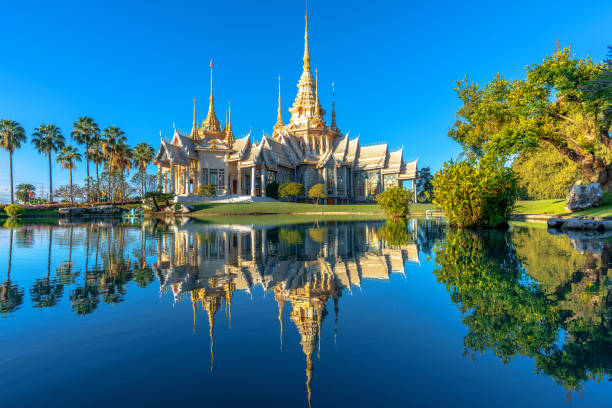
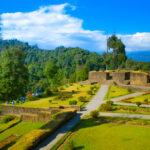
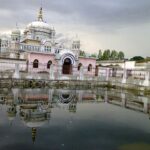
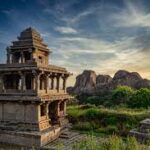
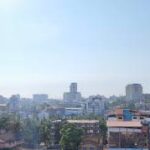

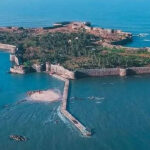
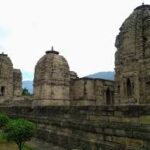
Pingback: Best Places to Visit in Nakhon Pathom – Explore Temples, Markets & Royal Sites